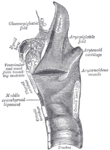- Hyoid bone
-
Bone: Hyoid bone Hyoid bone. Anterior surface. Enlarged. Anterolateral view of head and neck. Latin os hyoideum Gray's subject #45 177 Precursor 2nd and 3rd branchial arch[1] MeSH Hyoid+Bone The hyoid bone (lingual bone) (Latin os hyoideum) is a horseshoe-shaped bone situated in the anterior midline of the neck between the chin and the thyroid cartilage. At rest, it lies at the level of the base of the mandible in the front and the third cervical vertebra behind.
Unlike other bones, the hyoid is only distantly articulated to other bones by muscles or ligaments. The hyoid is anchored by muscles from the anterior, posterior, and inferior directions and aids in tongue movement and swallowing. The hyoid bone provides attachment to the muscles of the floor of the mouth and the tongue above, the larynx below, and the epiglottis and pharynx behind.
Its name is derived from the Greek word hyoeides meaning "shaped like the letter upsilon" (υ).
Contents
Segments
The bone consists of a central part, called the body and two pairs of cornua, the greater cornu and the lesser cornu.
- Body of hyoid
- Greater cornu (2)
- Lesser cornu (2)
Embryology
The second pharyngeal arch gives rise to the lesser cornu of hyoid and the superior part of body of hyoid. The cartilage of the third pharyngeal arch forms the greater cornu of hyoid and the lower portion of the body of hyoid.
Ossification
The hyoid is ossified from six centers: two for the body, and one for each cornu. Ossification commences in the greater cornua toward the end of fetal life, in the body shortly afterward, and in the lesser cornua during the first or second year after birth. Until middle age the connection between the body and greater cornu is fibrous.
Muscle attachments
The following muscles are attached to the hyoid:
- Superior
- Inferior
Function
The hyoid bone is present in many mammals, it allows a wider range of tongue, pharyngeal and laryngeal movements by bracing these structures alongside each other in order to produce variation.[2] Its descent in living creatures is not unique to Homo sapiens, and does not allow the production of a wide range of sounds: with a lower larynx, men do not produce a wider range of sounds than women and 2 year old babies. Moreover the larynx position of Neanderthal was not a handicap to producing speech sounds.[3] The discovery of a modern-looking hyoid bone of a Neanderthal man in the Kebara Cave in Palestine led its discoverers to argue that the Neanderthals had a descended larynx, and thus human-like speech capabilities.[4] However, other researchers have claimed that the morphology of the hyoid is not indicative of the larynx's position.[5] It is necessary to take into consideration the skull base, the mandible and the cervical vertebrae and a cranial reference plane.[6][7]
Fracture and applied anatomy
Due to its position, the hyoid bone is not susceptible to easy fracture. In a suspected case of murder, a fractured hyoid strongly indicates throttling or strangulation. However this is not the case in children and adolescents, where the hyoid bone is still flexible as ossification is yet to be completed.
In other animals
The hyoid bone is derived from the lower half of the second gill arch in fish, which separates the first gill slit from the spiracle, and is often referred to as the hyoid arch. In many animals, it also incorporates elements of other gill arches, and has a correspondingly greater number of cornua. Amphibians and reptiles may have many cornua, while mammals (including humans) have two pairs, and birds only one. In birds, and some reptiles, the body of the hyoid is greatly extended forward, creating a solid bony support for the tongue.[8] The howler monkey Alouatta has a pneumatized hyoid bone, one of the few cases of postcranial pneumatization of bones outside Saurischia.
Additional images
Coronal section of larynx and upper part of trachea.The entrance to the larynx, viewed from behind.Sagittal section of nose mouth, pharynx, and larynx.The thyroid gland and its relations.Front view of neck.See also
- Adam's apple
- Bone terminology
- Terms for anatomical location
References
Notes
- ^ hednk-023 — Embryology at UNC
- ^ http://www.pnas.org/cgi/content/full/100/12/6930 Descent of the larynx in chimpanzee infants
- ^ Boë, L.J. et al. The potential of Neandertal vowel space was as large as that of modern humans. Journal of Phonetics 30 (2002) 465-484.
- ^ Arsenburg, B. et al., A reappraisal of the anatomical basis for speech in middle Paleolithic hominids, in: American Journal of Physiological Anthropology 83 (1990), pp. 137-146.
- ^ Fitch, Tecumseh W., The evolution of speech: a comparative review, in: Trends in Cognitive Science, Vol. 4, No. 7, July 2000 (http://www3.isrl.uiuc.edu/~junwang4/langev/localcopy/pdf/fitch00speech.pdf)
- ^ Granat et al., Hyoid bone and larynx in Homo. Estimated position by biometrics, Biom. Hum. et Anthropolol., 2006, 24, 3-4, 243-255.
- ^ Boë, L.J. et al., Variation and prediction of the hyoid bone position for modern Man and Neanderthal, Biom. Hum. et Anthropolol., 2006, 24, 3-4, 257-271
- ^ Romer, Alfred Sherwood; Parsons, Thomas S. (1977). The Vertebrate Body. Philadelphia, PA: Holt-Saunders International. p. 214. ISBN 0-03-910284-X.
Sources
This article was originally based on an entry from a public domain edition of Gray's Anatomy. As such, some of the information contained within it may be outdated.
External links
- SUNY Labs 25:03-0101 - "Anterior Triangle of the Neck: The Muscular Triangle"
- Roche Lexicon - illustrated navigator, at Elsevier 25420.000-1
- lesson11 at The Anatomy Lesson by Wesley Norman (Georgetown University) (larynxskel1)
- Mnemonic:Muscles attached
Bones (TA A02, GA 2) Axial Thoracic skeletonFacial bonesnasal · maxilla · lacrimal · zygomatic · palatine · inferior nasal conchae · vomer · mandible · THROAT: hyoid (greater cornu, lesser cornu, body)Appendicular LowerCategories:- Irregular bones
- Head and neck
Wikimedia Foundation. 2010.

















